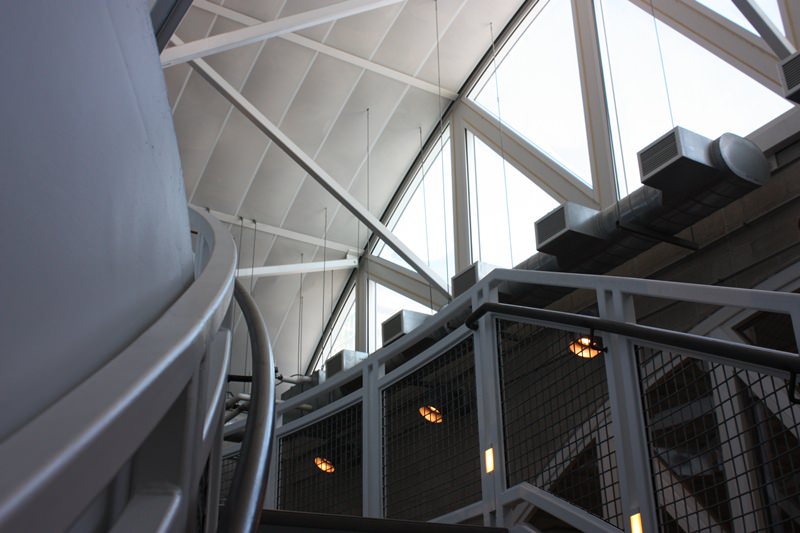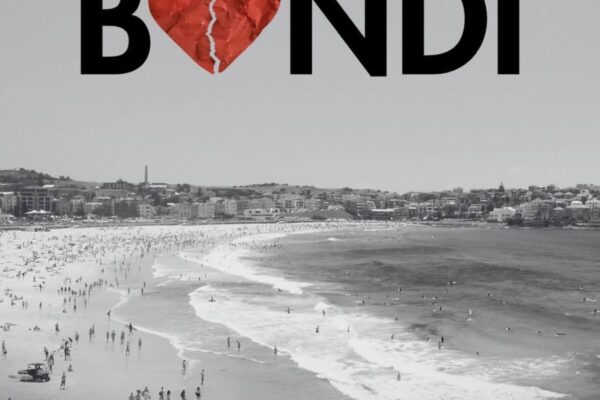 Detail of the museum’s “light” side (Chloe Riley)
Detail of the museum’s “light” side (Chloe Riley)
Like Star Wars, the space we’re currently standing in has physical “light” and “dark” sides, says my tour guide, a petite blonde who grew up in Chicago and “geeks out” over all things architecture.
She’s referring to a critical component of the overarching design of the Illinois Holocaust Museum and Education Center, a building designed by Chicago architect Stanley Tigerman which opened to the public in 2009. The light and dark refer to the architectural experience visitors are meant to have as they move through the museum, beginning with a stark industrial feel at the onset, ultimately moving towards rounded white rooms flooded with natural light. At the time it opened, Chicago Tribune architectural critic Blair Kamin called it both “moving and flawed.”
Today, we’ve just missed the school tours and the building is relatively quiet, save for TVs in the exhibits, many of which contain survivors talking, remembering.
Originally opened as a small storefront in Skokie in 1984, the Illinois Holocaust Museum initially came out of a protest to a neo-Nazi rally in the late 1970s. The rally never happened and instead, in 1981, the Holocaust Memorial Foundation of Illinois was formed, largely via the efforts of local survivors.
Though the museum had been testing an architectural tour since June, interest in the tour jumped after the museum’s participation in, the Chicago Architecture Biennial, according to Mary Gold, the Illinois Holocaust Museum’s vice president of marketing. (The CAB opened on Oct. 3 and closed earlier this week.)
When weather permits, the tour starts outside, with visitors standing before the Ferro Fountain of the Righteous, a tribute to many of the non-Jews who risked their lives to protect Jews during the Holocaust. Guides also point out the building’s exterior, with its east-facing white pavilion symbolizing the Jews’ anticipation of the Messiah and the darker pavilion facing southeast towards Jerusalem.
After that, it’s back inside for the rest of the tour which, since it doesn’t follow the museum’s typical path, has guests constantly moving back and forth between dark and light.
 Ferro Fountain of the Righteous (Chloe Riley)
Ferro Fountain of the Righteous (Chloe Riley)
There’s the Room of Remembrance, a circular space with six skylights representing the 6 million Jews killed in the Holocaust. Its centerpiece is a book of names, which includes local Holocaust survivors and their family members who were killed. The museum periodically turns the pages. One of the names on today’s page is Abe Lewin, whose 6-year-old son Nacha Lewin died in the gas chambers at Auschwitz in August 1944.
First names of the book’s dead, written in English, Hebrew and Yiddish, also line the room’s walls starting in a darker, smaller print towards the bottom and extending upwards into a large, grey font – a design meant to symbolize bodies rising through a chimney.
 Room of Remembrance (Chloe Riley)
Room of Remembrance (Chloe Riley)
Guests finish up in the Hall of Reflection, a vaulted space with natural light shining down on 12 black cubes, which represent the 12 tribes of Israel. It’s a place for guests to sit and take in the magnitude of their experience at the museum, my guide says.
 Hall of Reflection (Chloe Riley)
Hall of Reflection (Chloe Riley)
Throughout the tour, the museum’s centerpiece – a World War II era train boxcar – peeks out at unexpected angles through panels of glass and down darkly lit shafts. It’s a key artifact of the type used in deportations during Nazi Germany, according to my guide, and Tigerman designed the building to show it off as often as possible.
“The building is specifically designed to create an emotional experience,” she says. “People sometimes aren’t aware of how much the physical space that they’re in affects their experience of that space. The building tells our museum’s story almost as much as the exhibitions do.
The Illinois Holocaust Museum conducts architectural tours every second Sunday and fourth Saturday of the month from 11 a.m.-noon. Tour is free with general admission. For more information, head to the museum’s website.
Article originally published HERE.









